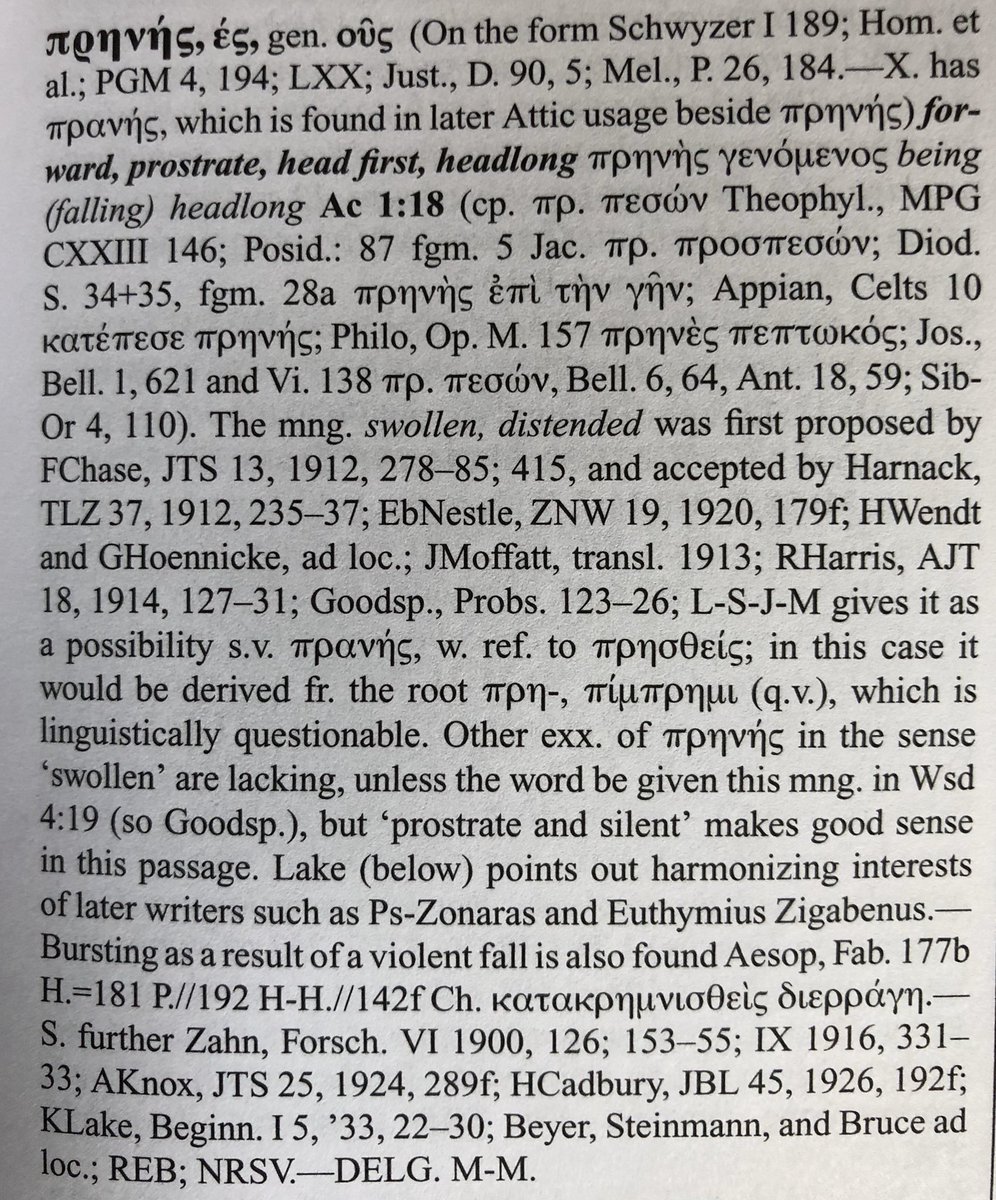THREAD: How did Judas Iscariot die? In a recent debate with @BartEhrman https://t.co/uwEISh5BU8 at 43-52 minutes we fell to discussing the mode of Judas’s death. Bart said that the accounts of Matthew & Acts were irreconcilable (& also reconcilable if you tried hard enough).
I made a couple of tactical mistakes: 1. not challenging his substitution of my word ‘headlong’ by ‘headfirst’ at 46:48 & 48:52. 2. focussing on the lexeme in Matthew, not the one in Acts.
But given enough time the tortoise can still get further than the hare. So here are some more leisurely reflections.
It has not always been obvious to readers that Matthew 27:5 & Acts 1:18 are in tension. For instance, NONE of the earliest translations of Acts give the meaning ‘(falling) headfirst’.
The 5th century Latin Vulgate has the 2 texts in harmony: Matthew: laqueo se suspendit ‘with a noose he hanged himself’ Acts: suspensus ‘having hanged’


The earlier Old Latin of Matthew already had Jerome’s reading.

The Latin of Codex Bezae (5th century or earlier) has et pronus factus ‘and having become prone [leaning face forward]’, delightful because it’s probably related to the word in the Greek original: prēnēs (πρηνής).

The Syriac Peshitta in Acts has ‘he fell on his face on the ground’.

The Middle Egyptian Coptic (last 3 words of 2nd line in picture) has ‘he fell on his face’. The main Coptic dialect, Sahidic, gives the same meaning (ⲀϤϨⲈ ⲈϪⲘ ⲠⲈϤϨⲞ). Both translations existed by the 5th century.

Though the translation ‘suspensus’ in the Latin might be trying to harmonise Acts with Matthew, the other versions just look like genuine attempts to render the Greek. The focus is on the final position being face down, not on a headfirst position during downward motion.
Moreover (BTW please help me to increase the use of ‘moreover’ in Twitter), English translations haven’t always given the impression of a conflict between Acts and Matthew.
Wycliffe of Acts: he was hangid (of course that comes from the Latin).

#WilliamTyndale 1526: when he was hanged

Ditto #MatthewsBible 1537:

Meanwhile #MartinLuther 1534: und sich erhenckt

The Puritan #GenevaBible of 1560 probably introduced ‘head long’ (can anyone find an earlier use of ‘headlong’?).

But of course ‘headlong’ is more ambiguous than ‘headfirst’, allowing for more horizontal falling & sometimes also describing landing position. The Geneva Bible is also paraphrasing using ‘he had throwen downe him selfe’.
The #BishopsBible 1568 kept ‘he was hanged’.

#KJV 1611 translators had a choice and plumped for ‘headlong’ from Geneva, but with a tad less paraphrase: ‘falling headlong’.

From then on ‘headlong’ became popular (e.g. ESV, NIV) and some translations (e.g. CSB, NLT) even go for ‘headfirst’.
So what does the Greek say? BDAG — a standard dictionary — allows both the meanings ‘prostrate’ (i.e. prone) & ‘headfirst’, & lists scholars who have held to a 3rd meaning ‘swelling up’.

So which does it mean? I don’t know. The data are underdetermined. That was precisely my point to Bart (though I should have made it more clearly). There are *numerous* possible scenarios in which both reports (Matthew & Acts) can be true. Why must I choose one?
If you want to show one or more author *must* have erred historically, you must show that none of the various permutations is possible. It’s insufficient to show that each individual permutation which doesn’t hypothesise error is improbable, for their probabilities combine.
So if the world’s most illustrious Bible sceptic gives as his choice illustration of NT error the death of Judas, it really isn’t clear to me that his belief is as demanded by the facts as he believes it is. Let the one with ears to hear, hear.

